University Assignment: Develop Work Priorities - BSBWOR404
VerifiedAdded on 2023/06/10
|7
|1333
|278
Homework Assignment
AI Summary
This assignment addresses key aspects of developing work priorities, including identifying factors affecting work objectives, strategies to mitigate their impact, and the use of business technology for planning and scheduling. It explores methods for self-assessment and obtaining feedback to improve personal performance. The assignment also touches upon quality assurance in a hospital setting, professional development activities, and tools for scheduling tasks. Furthermore, it outlines steps for preparing personal plans, establishing priorities, identifying learning needs, and eliciting, analyzing, and interpreting feedback. The solution covers topics relevant to the Diploma of Nursing course, specifically the BSBWOR404 unit, providing a comprehensive guide to effective work management and professional development.
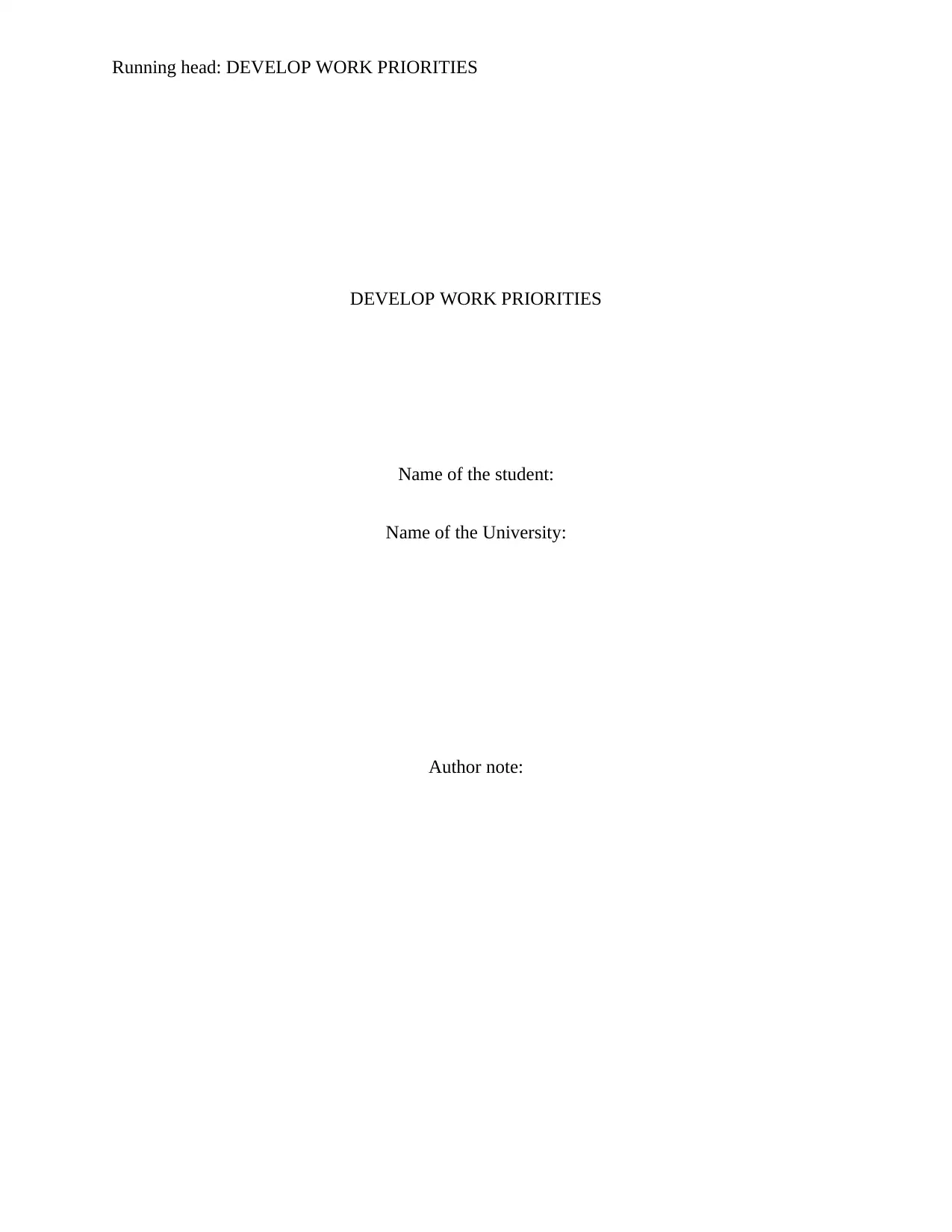
Running head: DEVELOP WORK PRIORITIES
DEVELOP WORK PRIORITIES
Name of the student:
Name of the University:
Author note:
DEVELOP WORK PRIORITIES
Name of the student:
Name of the University:
Author note:
Paraphrase This Document
Need a fresh take? Get an instant paraphrase of this document with our AI Paraphraser
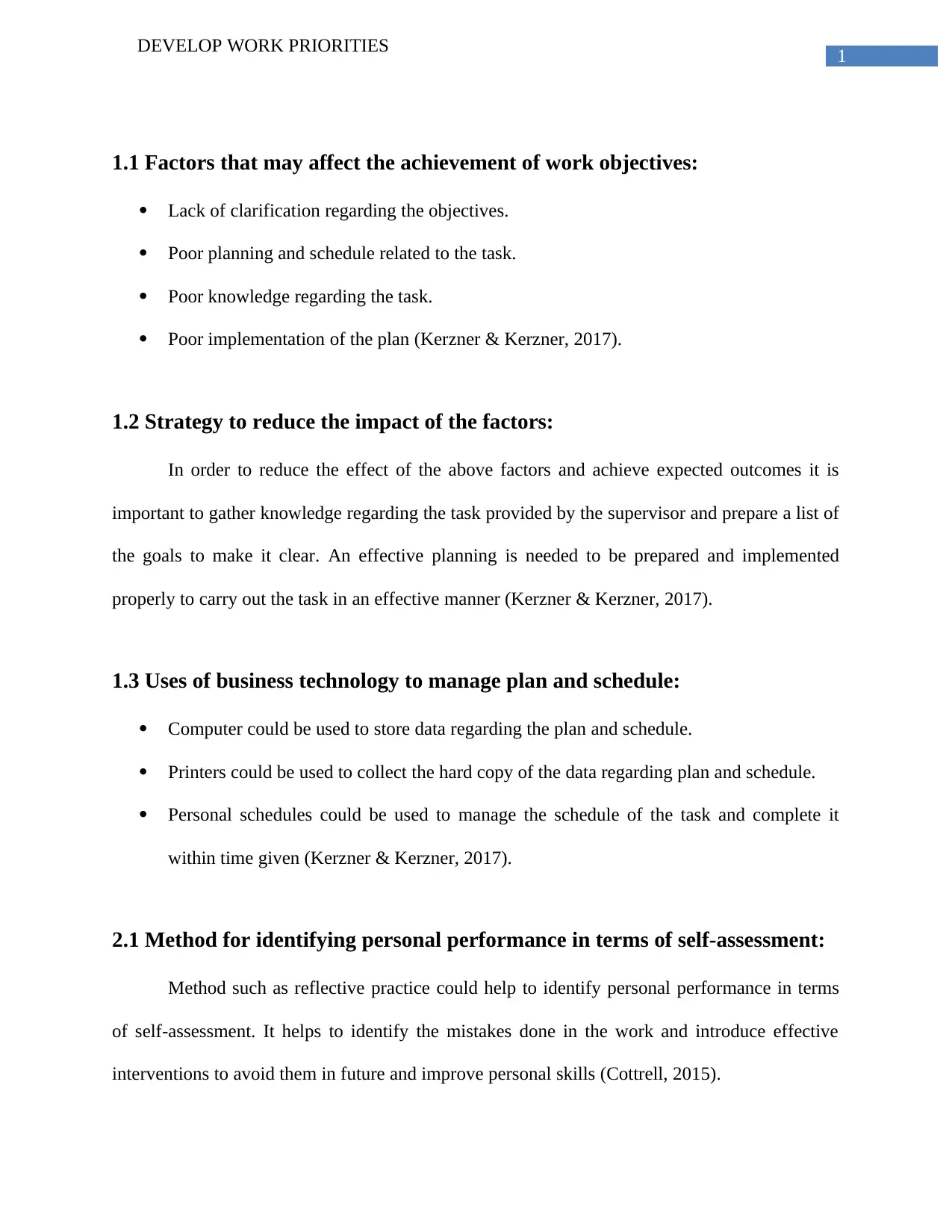
1
DEVELOP WORK PRIORITIES
1.1 Factors that may affect the achievement of work objectives:
Lack of clarification regarding the objectives.
Poor planning and schedule related to the task.
Poor knowledge regarding the task.
Poor implementation of the plan (Kerzner & Kerzner, 2017).
1.2 Strategy to reduce the impact of the factors:
In order to reduce the effect of the above factors and achieve expected outcomes it is
important to gather knowledge regarding the task provided by the supervisor and prepare a list of
the goals to make it clear. An effective planning is needed to be prepared and implemented
properly to carry out the task in an effective manner (Kerzner & Kerzner, 2017).
1.3 Uses of business technology to manage plan and schedule:
Computer could be used to store data regarding the plan and schedule.
Printers could be used to collect the hard copy of the data regarding plan and schedule.
Personal schedules could be used to manage the schedule of the task and complete it
within time given (Kerzner & Kerzner, 2017).
2.1 Method for identifying personal performance in terms of self-assessment:
Method such as reflective practice could help to identify personal performance in terms
of self-assessment. It helps to identify the mistakes done in the work and introduce effective
interventions to avoid them in future and improve personal skills (Cottrell, 2015).
DEVELOP WORK PRIORITIES
1.1 Factors that may affect the achievement of work objectives:
Lack of clarification regarding the objectives.
Poor planning and schedule related to the task.
Poor knowledge regarding the task.
Poor implementation of the plan (Kerzner & Kerzner, 2017).
1.2 Strategy to reduce the impact of the factors:
In order to reduce the effect of the above factors and achieve expected outcomes it is
important to gather knowledge regarding the task provided by the supervisor and prepare a list of
the goals to make it clear. An effective planning is needed to be prepared and implemented
properly to carry out the task in an effective manner (Kerzner & Kerzner, 2017).
1.3 Uses of business technology to manage plan and schedule:
Computer could be used to store data regarding the plan and schedule.
Printers could be used to collect the hard copy of the data regarding plan and schedule.
Personal schedules could be used to manage the schedule of the task and complete it
within time given (Kerzner & Kerzner, 2017).
2.1 Method for identifying personal performance in terms of self-assessment:
Method such as reflective practice could help to identify personal performance in terms
of self-assessment. It helps to identify the mistakes done in the work and introduce effective
interventions to avoid them in future and improve personal skills (Cottrell, 2015).
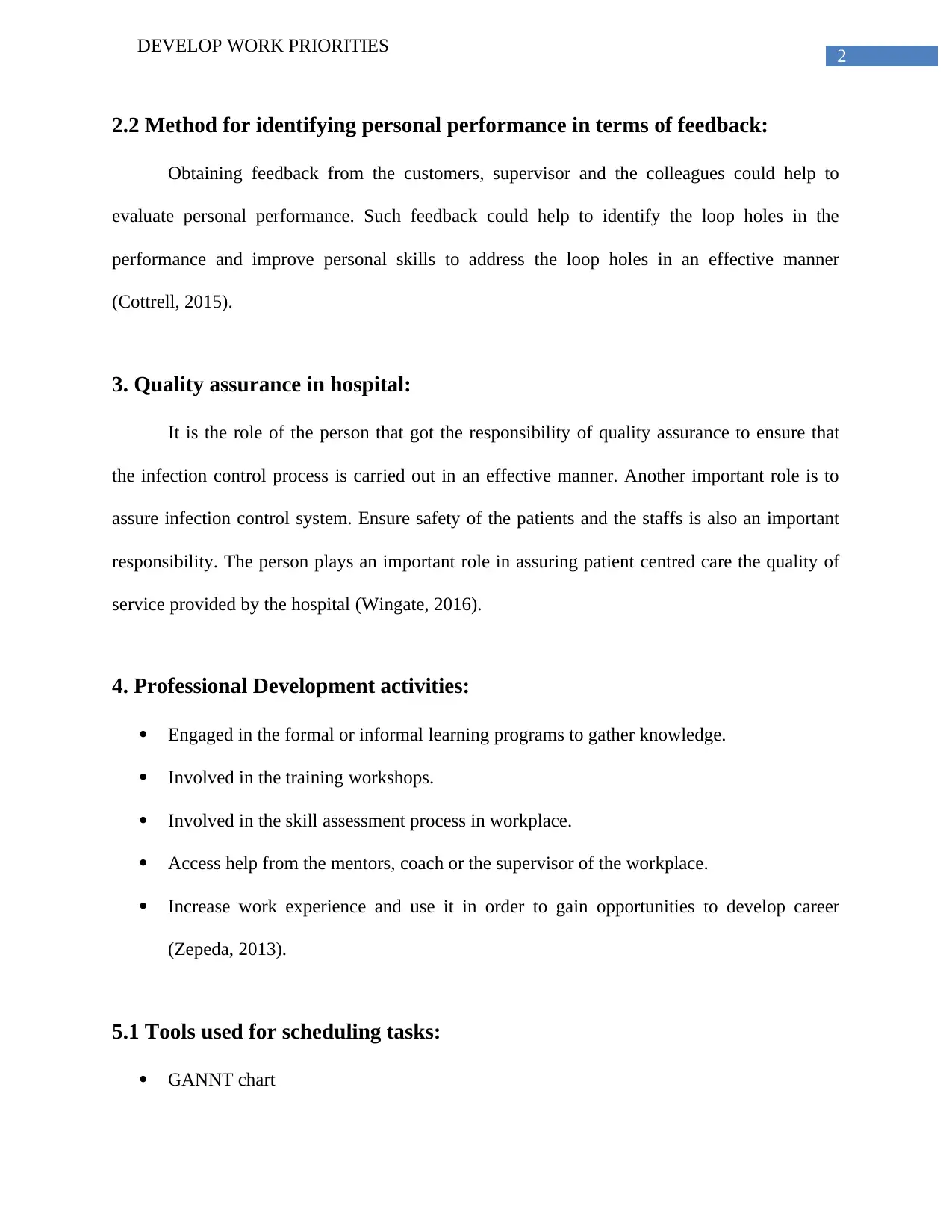
2
DEVELOP WORK PRIORITIES
2.2 Method for identifying personal performance in terms of feedback:
Obtaining feedback from the customers, supervisor and the colleagues could help to
evaluate personal performance. Such feedback could help to identify the loop holes in the
performance and improve personal skills to address the loop holes in an effective manner
(Cottrell, 2015).
3. Quality assurance in hospital:
It is the role of the person that got the responsibility of quality assurance to ensure that
the infection control process is carried out in an effective manner. Another important role is to
assure infection control system. Ensure safety of the patients and the staffs is also an important
responsibility. The person plays an important role in assuring patient centred care the quality of
service provided by the hospital (Wingate, 2016).
4. Professional Development activities:
Engaged in the formal or informal learning programs to gather knowledge.
Involved in the training workshops.
Involved in the skill assessment process in workplace.
Access help from the mentors, coach or the supervisor of the workplace.
Increase work experience and use it in order to gain opportunities to develop career
(Zepeda, 2013).
5.1 Tools used for scheduling tasks:
GANNT chart
DEVELOP WORK PRIORITIES
2.2 Method for identifying personal performance in terms of feedback:
Obtaining feedback from the customers, supervisor and the colleagues could help to
evaluate personal performance. Such feedback could help to identify the loop holes in the
performance and improve personal skills to address the loop holes in an effective manner
(Cottrell, 2015).
3. Quality assurance in hospital:
It is the role of the person that got the responsibility of quality assurance to ensure that
the infection control process is carried out in an effective manner. Another important role is to
assure infection control system. Ensure safety of the patients and the staffs is also an important
responsibility. The person plays an important role in assuring patient centred care the quality of
service provided by the hospital (Wingate, 2016).
4. Professional Development activities:
Engaged in the formal or informal learning programs to gather knowledge.
Involved in the training workshops.
Involved in the skill assessment process in workplace.
Access help from the mentors, coach or the supervisor of the workplace.
Increase work experience and use it in order to gain opportunities to develop career
(Zepeda, 2013).
5.1 Tools used for scheduling tasks:
GANNT chart
⊘ This is a preview!⊘
Do you want full access?
Subscribe today to unlock all pages.

Trusted by 1+ million students worldwide
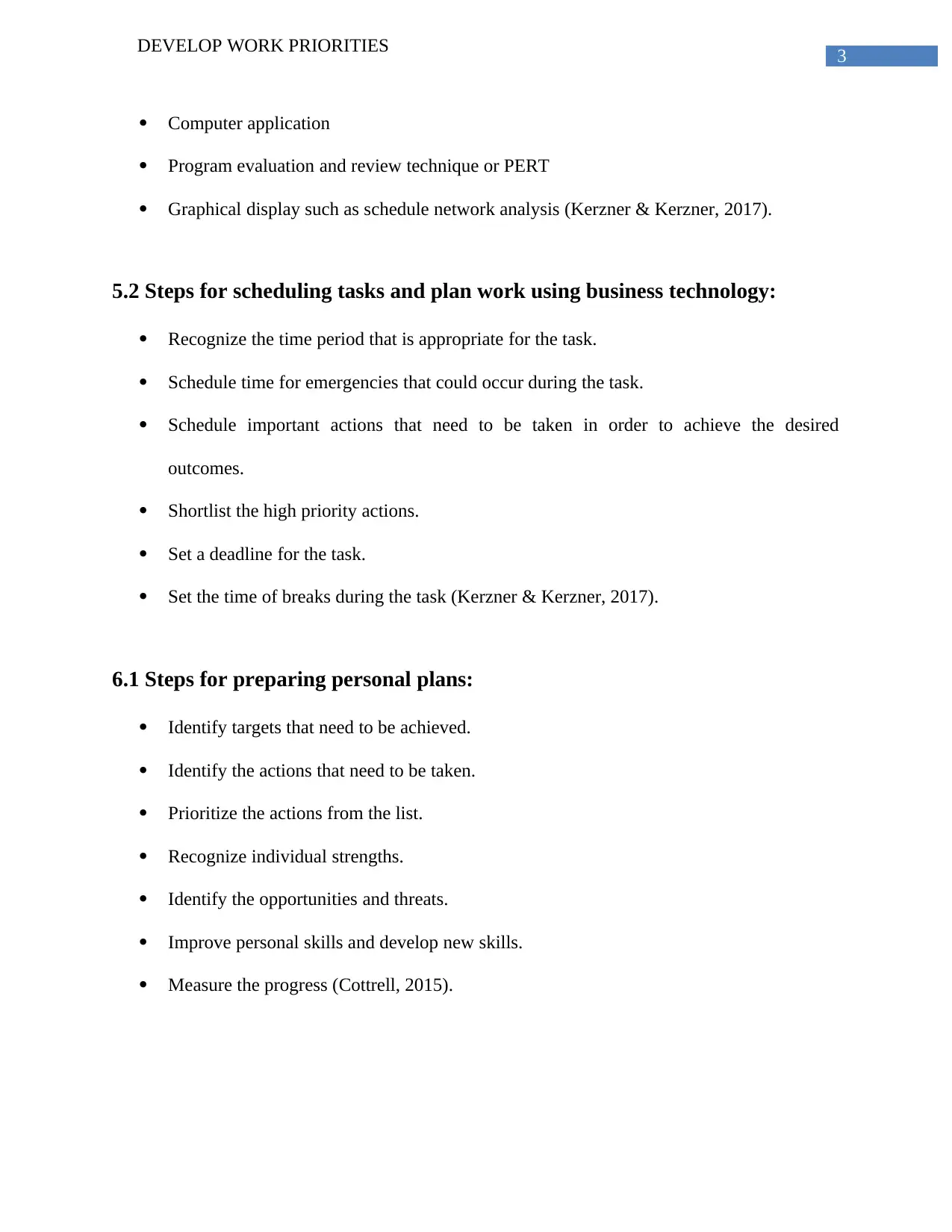
3
DEVELOP WORK PRIORITIES
Computer application
Program evaluation and review technique or PERT
Graphical display such as schedule network analysis (Kerzner & Kerzner, 2017).
5.2 Steps for scheduling tasks and plan work using business technology:
Recognize the time period that is appropriate for the task.
Schedule time for emergencies that could occur during the task.
Schedule important actions that need to be taken in order to achieve the desired
outcomes.
Shortlist the high priority actions.
Set a deadline for the task.
Set the time of breaks during the task (Kerzner & Kerzner, 2017).
6.1 Steps for preparing personal plans:
Identify targets that need to be achieved.
Identify the actions that need to be taken.
Prioritize the actions from the list.
Recognize individual strengths.
Identify the opportunities and threats.
Improve personal skills and develop new skills.
Measure the progress (Cottrell, 2015).
DEVELOP WORK PRIORITIES
Computer application
Program evaluation and review technique or PERT
Graphical display such as schedule network analysis (Kerzner & Kerzner, 2017).
5.2 Steps for scheduling tasks and plan work using business technology:
Recognize the time period that is appropriate for the task.
Schedule time for emergencies that could occur during the task.
Schedule important actions that need to be taken in order to achieve the desired
outcomes.
Shortlist the high priority actions.
Set a deadline for the task.
Set the time of breaks during the task (Kerzner & Kerzner, 2017).
6.1 Steps for preparing personal plans:
Identify targets that need to be achieved.
Identify the actions that need to be taken.
Prioritize the actions from the list.
Recognize individual strengths.
Identify the opportunities and threats.
Improve personal skills and develop new skills.
Measure the progress (Cottrell, 2015).
Paraphrase This Document
Need a fresh take? Get an instant paraphrase of this document with our AI Paraphraser
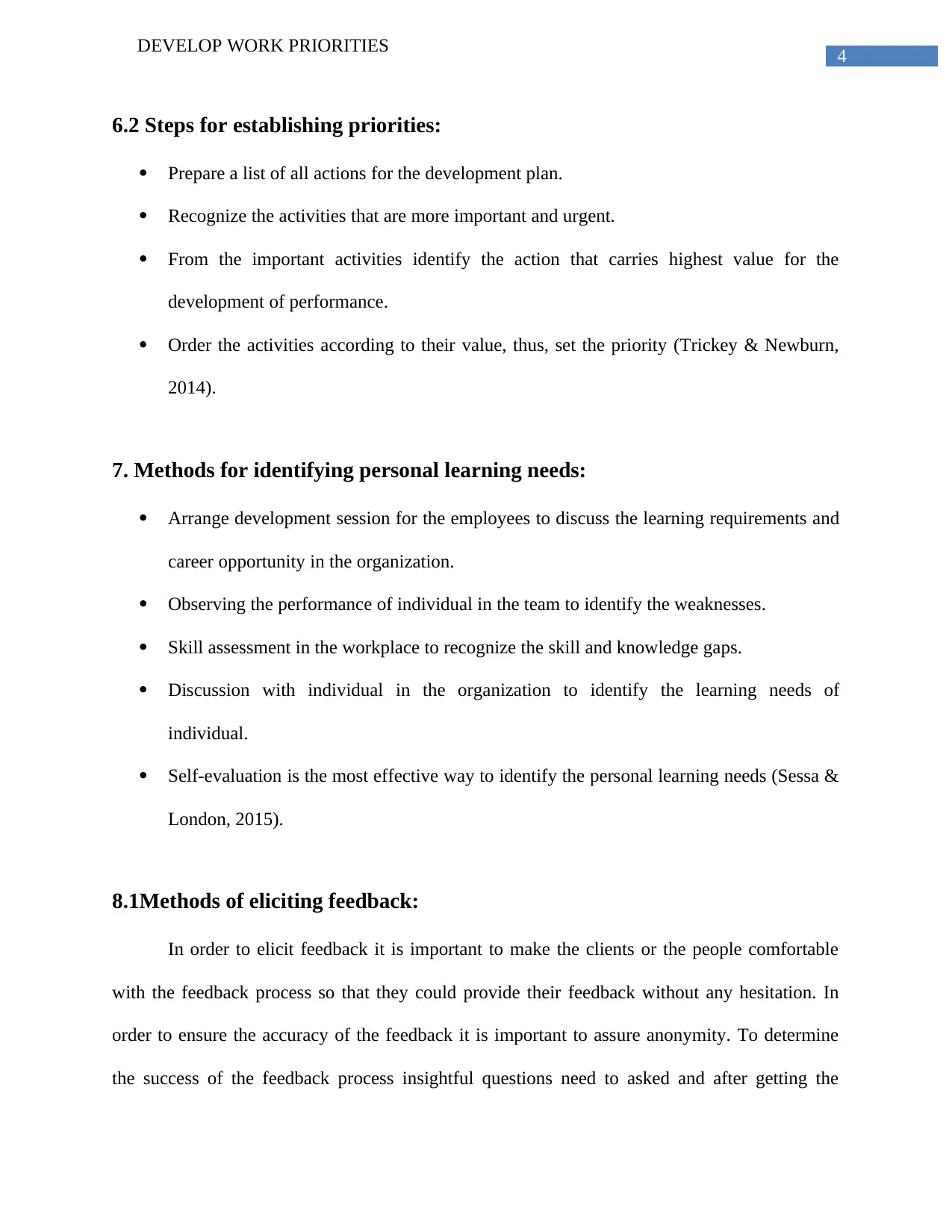
4
DEVELOP WORK PRIORITIES
6.2 Steps for establishing priorities:
Prepare a list of all actions for the development plan.
Recognize the activities that are more important and urgent.
From the important activities identify the action that carries highest value for the
development of performance.
Order the activities according to their value, thus, set the priority (Trickey & Newburn,
2014).
7. Methods for identifying personal learning needs:
Arrange development session for the employees to discuss the learning requirements and
career opportunity in the organization.
Observing the performance of individual in the team to identify the weaknesses.
Skill assessment in the workplace to recognize the skill and knowledge gaps.
Discussion with individual in the organization to identify the learning needs of
individual.
Self-evaluation is the most effective way to identify the personal learning needs (Sessa &
London, 2015).
8.1Methods of eliciting feedback:
In order to elicit feedback it is important to make the clients or the people comfortable
with the feedback process so that they could provide their feedback without any hesitation. In
order to ensure the accuracy of the feedback it is important to assure anonymity. To determine
the success of the feedback process insightful questions need to asked and after getting the
DEVELOP WORK PRIORITIES
6.2 Steps for establishing priorities:
Prepare a list of all actions for the development plan.
Recognize the activities that are more important and urgent.
From the important activities identify the action that carries highest value for the
development of performance.
Order the activities according to their value, thus, set the priority (Trickey & Newburn,
2014).
7. Methods for identifying personal learning needs:
Arrange development session for the employees to discuss the learning requirements and
career opportunity in the organization.
Observing the performance of individual in the team to identify the weaknesses.
Skill assessment in the workplace to recognize the skill and knowledge gaps.
Discussion with individual in the organization to identify the learning needs of
individual.
Self-evaluation is the most effective way to identify the personal learning needs (Sessa &
London, 2015).
8.1Methods of eliciting feedback:
In order to elicit feedback it is important to make the clients or the people comfortable
with the feedback process so that they could provide their feedback without any hesitation. In
order to ensure the accuracy of the feedback it is important to assure anonymity. To determine
the success of the feedback process insightful questions need to asked and after getting the
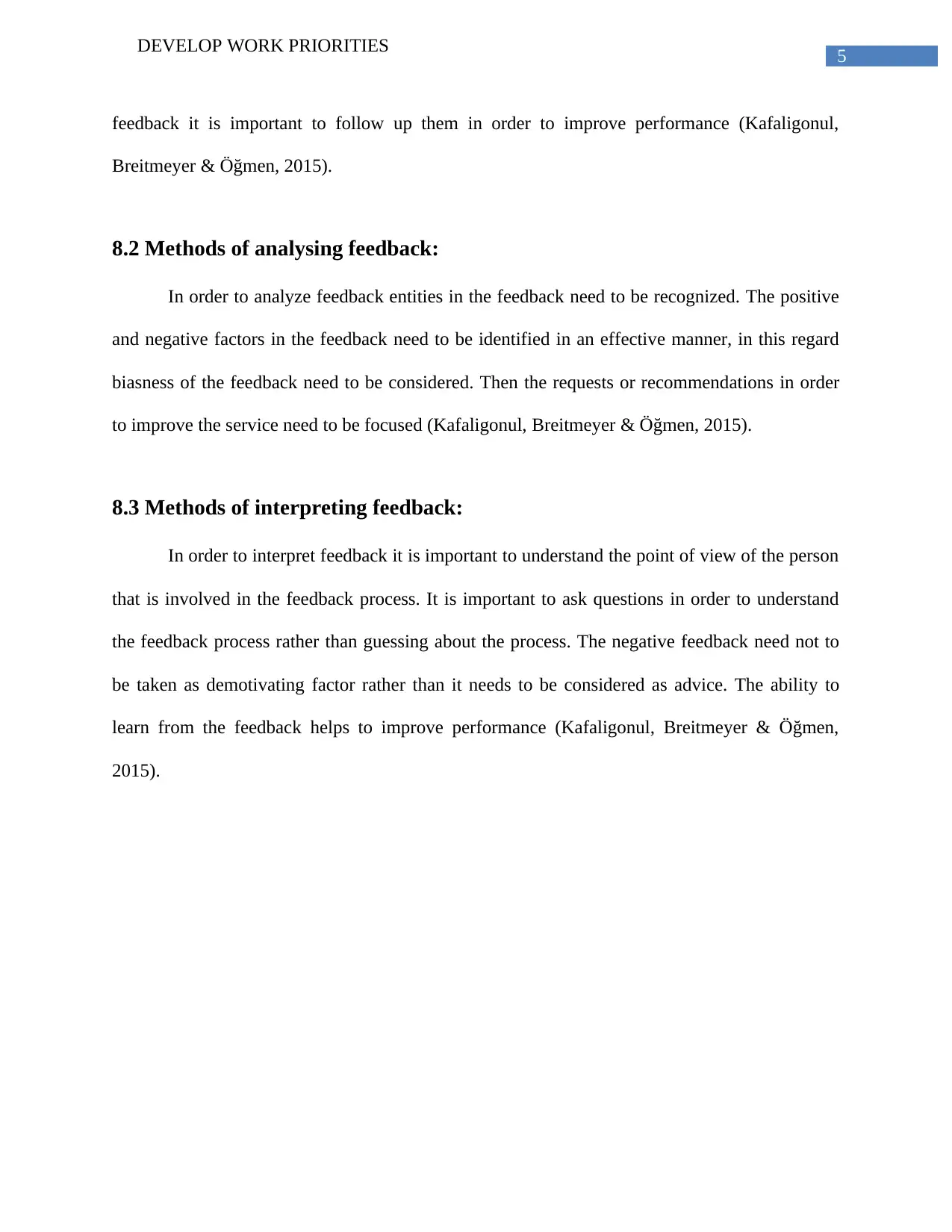
5
DEVELOP WORK PRIORITIES
feedback it is important to follow up them in order to improve performance (Kafaligonul,
Breitmeyer & Öğmen, 2015).
8.2 Methods of analysing feedback:
In order to analyze feedback entities in the feedback need to be recognized. The positive
and negative factors in the feedback need to be identified in an effective manner, in this regard
biasness of the feedback need to be considered. Then the requests or recommendations in order
to improve the service need to be focused (Kafaligonul, Breitmeyer & Öğmen, 2015).
8.3 Methods of interpreting feedback:
In order to interpret feedback it is important to understand the point of view of the person
that is involved in the feedback process. It is important to ask questions in order to understand
the feedback process rather than guessing about the process. The negative feedback need not to
be taken as demotivating factor rather than it needs to be considered as advice. The ability to
learn from the feedback helps to improve performance (Kafaligonul, Breitmeyer & Öğmen,
2015).
DEVELOP WORK PRIORITIES
feedback it is important to follow up them in order to improve performance (Kafaligonul,
Breitmeyer & Öğmen, 2015).
8.2 Methods of analysing feedback:
In order to analyze feedback entities in the feedback need to be recognized. The positive
and negative factors in the feedback need to be identified in an effective manner, in this regard
biasness of the feedback need to be considered. Then the requests or recommendations in order
to improve the service need to be focused (Kafaligonul, Breitmeyer & Öğmen, 2015).
8.3 Methods of interpreting feedback:
In order to interpret feedback it is important to understand the point of view of the person
that is involved in the feedback process. It is important to ask questions in order to understand
the feedback process rather than guessing about the process. The negative feedback need not to
be taken as demotivating factor rather than it needs to be considered as advice. The ability to
learn from the feedback helps to improve performance (Kafaligonul, Breitmeyer & Öğmen,
2015).
⊘ This is a preview!⊘
Do you want full access?
Subscribe today to unlock all pages.

Trusted by 1+ million students worldwide
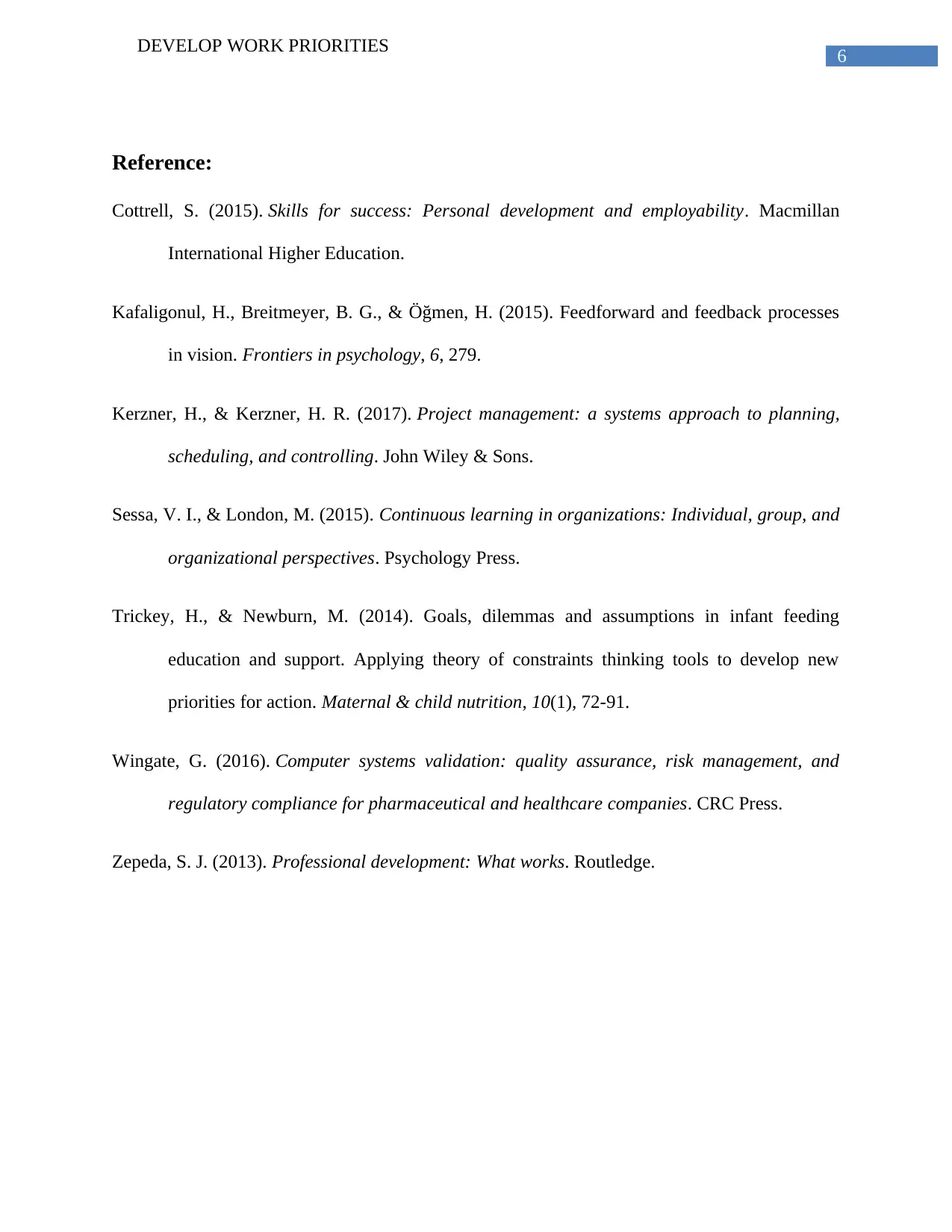
6
DEVELOP WORK PRIORITIES
Reference:
Cottrell, S. (2015). Skills for success: Personal development and employability. Macmillan
International Higher Education.
Kafaligonul, H., Breitmeyer, B. G., & Öğmen, H. (2015). Feedforward and feedback processes
in vision. Frontiers in psychology, 6, 279.
Kerzner, H., & Kerzner, H. R. (2017). Project management: a systems approach to planning,
scheduling, and controlling. John Wiley & Sons.
Sessa, V. I., & London, M. (2015). Continuous learning in organizations: Individual, group, and
organizational perspectives. Psychology Press.
Trickey, H., & Newburn, M. (2014). Goals, dilemmas and assumptions in infant feeding
education and support. Applying theory of constraints thinking tools to develop new
priorities for action. Maternal & child nutrition, 10(1), 72-91.
Wingate, G. (2016). Computer systems validation: quality assurance, risk management, and
regulatory compliance for pharmaceutical and healthcare companies. CRC Press.
Zepeda, S. J. (2013). Professional development: What works. Routledge.
DEVELOP WORK PRIORITIES
Reference:
Cottrell, S. (2015). Skills for success: Personal development and employability. Macmillan
International Higher Education.
Kafaligonul, H., Breitmeyer, B. G., & Öğmen, H. (2015). Feedforward and feedback processes
in vision. Frontiers in psychology, 6, 279.
Kerzner, H., & Kerzner, H. R. (2017). Project management: a systems approach to planning,
scheduling, and controlling. John Wiley & Sons.
Sessa, V. I., & London, M. (2015). Continuous learning in organizations: Individual, group, and
organizational perspectives. Psychology Press.
Trickey, H., & Newburn, M. (2014). Goals, dilemmas and assumptions in infant feeding
education and support. Applying theory of constraints thinking tools to develop new
priorities for action. Maternal & child nutrition, 10(1), 72-91.
Wingate, G. (2016). Computer systems validation: quality assurance, risk management, and
regulatory compliance for pharmaceutical and healthcare companies. CRC Press.
Zepeda, S. J. (2013). Professional development: What works. Routledge.
1 out of 7
Related Documents
Your All-in-One AI-Powered Toolkit for Academic Success.
+13062052269
info@desklib.com
Available 24*7 on WhatsApp / Email
![[object Object]](/_next/static/media/star-bottom.7253800d.svg)
Unlock your academic potential
Copyright © 2020–2025 A2Z Services. All Rights Reserved. Developed and managed by ZUCOL.




